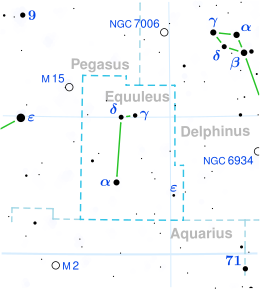| Observation data Epoch J2000 Equinox J2000 | |
|---|---|
| Constellation | Equuleus |
| Right ascension | 21h 08m 28.1388s[1] |
| Declination | +06° 59′ 21.6948″[1] |
| Apparent magnitude (V) | 6.14[2] |
| Characteristics | |
| Evolutionary stage | red giant branch?[3] |
| Spectral type | M0 III[4] |
| U−B color index | +1.97[5] |
| B−V color index | +1.66[5] |
| Astrometry | |
| Radial velocity (Rv) | 20 ± 2[6] km/s |
| Proper motion (μ) | RA: −10.643 mas/yr[1] Dec.: +2.479 mas/yr[1] |
| Parallax (π) | 2.8646 ± 0.0533 mas[1] |
| Distance | 1,140 ± 20 ly (349 ± 6 pc) |
| Absolute magnitude (MV) | −1.57[note 1] |
| Details | |
| Mass | 1.83[7] M☉ |
| Radius | 117[7] R☉ |
| Luminosity | 1,648[8] L☉ |
| Surface gravity (log g) | 0.413[9] cgs |
| Temperature | 3,732[8] K |
| Rotational velocity (v sin i) | 4.5 ± 1[10] km/s |
| Other designations | |
| Database references | |
| SIMBAD | data |
HD 201298 (HR 8090) is a solitary star located in the northern constellation Equuleus just next to 3 Equulei It has an apparent magnitude of 6.14,[2] making it barely visible to the naked eye under ideal conditions. The star is situated at a distance of 1,140 light years[1] but is drifting away with a heliocentric radial velocity of 20 km/s.[6]
HD 201298 has a stellar classification of M0 III, indicating that it is ageing M-type star[4] that is probably on the red giant branch.[3] As a result, it has expanded to 117 times the Sun's girth.[7] At present it has 1.83 times the mass of the Sun[7] and shines with a luminosity of 1,648 L☉ from its enlarged photosphere at an effective temperature of 3,732 K,[8] which gives it an orange glow. HD 201298 spins leisurely with a projected rotational velocity of 4.5±1 km/s,[10] slightly faster than most giants.
Note
- ^ Calculated using this equation:
References
- ^ a b c d e Brown, A. G. A.; et al. (Gaia collaboration) (2021). "Gaia Early Data Release 3: Summary of the contents and survey properties". Astronomy & Astrophysics. 649: A1. arXiv:2012.01533. Bibcode:2021A&A...649A...1G. doi:10.1051/0004-6361/202039657. S2CID 227254300. (Erratum: doi:10.1051/0004-6361/202039657e). Gaia EDR3 record for this source at VizieR.
- ^ a b Anderson, E.; Francis, Ch. (May 2012). "XHIP: An extended hipparcos compilation". Astronomy Letters. 38 (5): 331–346. arXiv:1108.4971. Bibcode:2012AstL...38..331A. doi:10.1134/S1063773712050015. ISSN 1063-7737. S2CID 255204555.
- ^ a b Gontcharov, G. A. (October 2011). "The red giant branch in the Tycho-2 catalogue". Astronomy Letters. 37 (10): 707–717. arXiv:1607.00557. Bibcode:2011AstL...37..707G. doi:10.1134/S1063773711090040. ISSN 1063-7737. S2CID 119272127.
- ^ a b Henry, Gregory W.; Fekel, Francis C.; Henry, Stephen M.; Hall, Douglas S. (September 2000). "Photometric Variability in a Sample of 187 G and K Giants". The Astrophysical Journal Supplement Series. 130 (1): 201–225. Bibcode:2000ApJS..130..201H. doi:10.1086/317346. ISSN 0067-0049.
- ^ a b Johnson, H. L.; Mitchell, R. I.; Iriarte, B.; Wisniewski, W. Z. (1 January 1966). "UBVRIJKL Photometry of the Bright Stars". Communications of the Lunar and Planetary Laboratory. 4: 99–110. Bibcode:1966CoLPL...4...99J.
- ^ a b Wilson, Ralph Elmer (1953). "General catalogue of stellar radial velocities". Carnegie Institute Washington D.C. Publication: 0. Bibcode:1953GCRV..C......0W.
- ^ a b c d Kervella, Pierre; Arenou, Frédéric; Thévenin, Frédéric (2022). "Stellar and substellar companions from Gaia EDR3". Astronomy & Astrophysics. 657: A7. arXiv:2109.10912. Bibcode:2022A&A...657A...7K. doi:10.1051/0004-6361/202142146. eISSN 1432-0746. ISSN 0004-6361.
- ^ a b c McDonald, I.; Zijlstra, A. A.; Boyer, M. L. (21 November 2012). "Fundamental parameters and infrared excesses of Hipparcos stars: Parameters and IR excesses from Hipparcos". Monthly Notices of the Royal Astronomical Society. 427 (1): 343–357. arXiv:1208.2037. Bibcode:2012MNRAS.427..343M. doi:10.1111/j.1365-2966.2012.21873.x. ISSN 0035-8711.
- ^ McDonald, I.; Zijlstra, A. A.; Watson, R. A. (2017). "Fundamental parameters and infrared excesses of Tycho-Gaia stars". Monthly Notices of the Royal Astronomical Society. 471 (1): 770. arXiv:1706.02208. Bibcode:2017MNRAS.471..770M. doi:10.1093/mnras/stx1433.
- ^ a b de Medeiros, J. R.; Mayor, M. (November 1999). "A catalog of rotational and radial velocities for evolved stars". Astronomy and Astrophysics Supplement Series. 139 (3): 433–460. Bibcode:1999A&AS..139..433D. doi:10.1051/aas:1999401. ISSN 0365-0138.
- ^ "HD 201298". SIMBAD. Centre de données astronomiques de Strasbourg. Retrieved June 20, 2022.
- ^ Gould, Benjamin Apthorp (1878). "Uranometria Argentina : brillantez y posicion de las estrellas fijas, hasta la septima magnitud, comprendidas dentro de cien grados del polo austral : con atlas". Resultados del Observatorio Nacional Argentino. 1. Bibcode:1879RNAO....1.....G.


